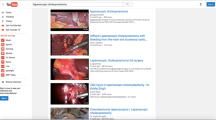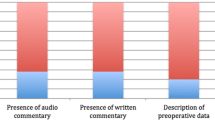Abstract
Introduction
YouTube is the most used platform for case preparation by surgical trainees. Despite its popular use, studies have noted limitations in surgical technique, safety, and vetting of these videos. This study identified the most viewed laparoscopic cholecystectomy (LC) videos on YouTube and analyzed the ability of attendings, residents, and medical students to identify critical portions of the procedure, technique, and limitations of the videos.
Methods
An incognito search was conducted on YouTube using the term “laparoscopic cholecystectomy.” Results were screened for length, publication date, and language. The top ten most viewed videos were presented to general surgery attendings, residents, and medical students at a single academic institution. Established rubrics were used for evaluation, including the Critical View of Safety (CVS) for LC, a modified Global Operative Assessment of Laparoscopic Skills (GOALS) score, a task-specific checklist, and visual analog scales for case difficulty and operator competence. Educational quality and likelihood of video recommendation for case preparation were evaluated using a Likert scale. Attending assessments were considered the gold standard.
Results
Six attending surgeons achieved excellent internal consistency on CVS, educational quality, and likelihood of recommendation scales, with Cronbach alpha (⍺) of 0.93, 0.92, and 0.92, respectively. ⍺ was ≥ 0.7 in all the other scales measured. Attending evaluations revealed that only one of the ten videos attained all three established CVS criteria. Four videos demonstrated none of the CVS criteria. The mean educational quality (mEQ) was 4.63 on a 10-point scale. The mean likelihood of recommendation (mLoR) for case preparation was 2.3 on a 5-point scale. Senior resident assessments (Postgraduate Year (PGY)4 + , n = 12) aligned with attending surgeons, with no statistically significant differences in CVS attainment, mEQ, and mLoR. Junior residents (PGY1-3, n = 17) and medical students (MS3-4, n = 20) exhibited significant difference with attendings in CVS attainment, mEQ, and mLoR for more than half the videos. Both groups tended to overrate videos compared to attendings.
Conclusion
YouTube is the most popular unvetted resource used for case presentation by surgical trainees. Attending evaluations revealed that the most viewed LC videos on YouTube did not attain the CVS, and were deemed as inappropriate for case preparation, with low educational value. Senior resident video assessments closely aligned with attendings, while junior trainees were more likely to overstate video quality and value. Attending guidance and direction of trainees to high-quality, vetted resources for surgical case preparation is needed. This may also suggest a need for surgical societies with platforms for video sharing to prioritize the creation and dissemination of high-quality videos on easily accessible public platforms.
Similar content being viewed by others
References
Topps D, Helmer J, Ellaway R (2013) YouTube as a platform for publishing clinical skills training videos. Acad Med 88:192–197
Deal SB, Alseidi AA (2017) Concerns of quality and safety in public domain surgical education videos: an assessment of the critical view of safety in frequently used laparoscopic cholecystectomy videos. J Am Coll Surg. https://doi.org/10.1016/j.jamcollsurg.2017.08.016
Rodriguez HA, Young MT, Jackson HT, Oelschlager BK, Wright AS (2018) Viewer discretion advised: is YouTube a friend or foe in surgical education? Surg Endosc. https://doi.org/10.1007/s00464-017-5853-x
Farag M, Bolton D, Lawrentschuk N (2020) Use of YouTube as a resource for surgical education-clarity or confusion. Eur Urol Focus. https://doi.org/10.1016/j.euf.2019.09.017
Pitcher GS, Newton DH, Amendola MF (2017) Common femoral artery access on YouTube: What practices are being shown and who is delivering the message? J Surg Educ. https://doi.org/10.1016/j.jsurg.2016.11.012
Rapp AK, Healy MG, Charlton ME, Keith JN, Rosenbaum ME, Kapadia MR (2016) YouTube is the most frequently used educational video source for surgical preparation. J Surg Educ. https://doi.org/10.1016/j.jsurg.2016.04.024
Buddingh KT, Nieuwenhuijs VB, van Buuren L, Hulscher JB, de Jong JS, van Dam GM (2011) Intraoperative assessment of biliary anatomy for prevention of bile duct injury: a review of current and future patient safety interventions. Surg Endosc. https://doi.org/10.1007/s00464-011-1639-8
De’Angelis N, Gavriilidis P, Martínez-Pérez A, Genova P, Notarnicola M, Reitano E, Petrucciani N, Abdalla S, Memeo R, Brunetti F, Carra MC, Di Saverio S, Celentano V (2019) Educational value of surgical videos on YouTube: quality assessment of laparoscopic appendectomy videos by senior surgeons vs novice trainees. World J Emerg Surg. https://doi.org/10.1186/s13017-019-0241-6
Sanford DE, Strasberg SM (2014) A simple effective method for generation of a permanent record of the Critical View of Safety during laparoscopic cholecystectomy by intraoperative “doublet” photography. J Am Coll Surg. https://doi.org/10.1016/j.jamcollsurg.2013.11.003
Vassiliou MC, Feldman LS, Andrew CG, Bergman S, Leffondré K, Stanbridge D, Fried GM (2005) A global assessment tool for evaluation of intraoperative laparoscopic skills. Am J Surg 190:107–113
Harris PA, Taylor R, Thielke R, Payne J, Gonzalez N, Conde JG (2009) Research electronic data capture (REDCap)–a metadata-driven methodology and workflow process for providing translational research informatics support. J Biomed Inform. https://doi.org/10.1016/j.jbi.2008.08.010
Choy I, Fecso A, Kwong J, Jackson T, Okrainec A (2013) Remote evaluation of laparoscopic performance using the global operative assessment of laparoscopic skills. Surg Endosc. https://doi.org/10.1007/s00464-012-2456-4
Chen CB, Palazzo F, Doane SM, Winter JM, Lavu H, Chojnacki KA, Rosato EL, Yeo CJ, Pucci MJ (2017) Increasing resident utilization and recognition of the critical view of safety during laparoscopic cholecystectomy: a pilot study from an academic medical center. Surg Endosc. https://doi.org/10.1007/s00464-016-5150-0
Lee JS, Seo HS, Hong TH (2015) YouTube as a potential training method for laparoscopic cholecystectomy. Ann Surg Treat Res. https://doi.org/10.4174/astr.2015.89.2.92,Jul0
Strasberg SM, Brunt LM (2010) Rationale and use of the critical view of safety in laparoscopic cholecystectomy. J Am Coll Surg 211(1):132–138
Sanford DE, Strasberg SM (2014) A simple effective method for generation of a permanent record of the Critical View of Safety during laparoscopic cholecystectomy by intraoperative “doublet” photography. J Am Coll Surg 218(2):170–178. https://doi.org/10.1016/j.jamcollsurg.2013.11.003
Pucher PH, Brunt LM, Fanelli RD, Asbun HJ, Aggarwal R (2015) SAGES expert Delphi consensus: critical factors for safe surgical practice in laparoscopic cholecystectomy. Surg Endosc 29:1–12. https://doi.org/10.1007/s00464-015-4079-z
Acknowledgements
We would like to acknowledge the George Washington University general surgery residents during the 2019-20 academic year as well as medical students who rotated through the department in July 2020 for participating in this educational activity and completing the video evaluation surveys.
Author information
Authors and Affiliations
Corresponding author
Ethics declarations
Disclosures
Dr. Hope T. Jackson, Dr. Chen-min S. Hung, Dr. Deepika Potarazu, Dr. Noor Habboosh, Dr. Erik J. DeAngelis, Dr. Richard L. Amdur, Dr. Jordan M. Estroff, Dr. Megan T. Quintana, Dr. Paul Lin, Dr. Khashayar Vaziri and Dr. Juliet Lee have no conflicts of interest or financial ties to disclose.
Additional information
Publisher's Note
Springer Nature remains neutral with regard to jurisdictional claims in published maps and institutional affiliations.
Supplementary Information
Below is the link to the electronic supplementary material.
Rights and permissions
About this article
Cite this article
Jackson, H.T., Hung, Cm.S., Potarazu, D. et al. Attending guidance advised: educational quality of surgical videos on YouTube. Surg Endosc 36, 4189–4198 (2022). https://doi.org/10.1007/s00464-021-08751-0
Received:
Accepted:
Published:
Issue Date:
DOI: https://doi.org/10.1007/s00464-021-08751-0




